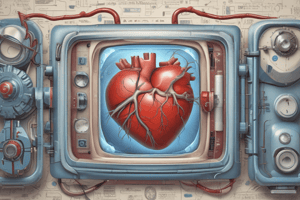Podcast
Questions and Answers
What is the primary goal of pharmacologic interventions in the treatment of cardiac disease?
What is the primary goal of pharmacologic interventions in the treatment of cardiac disease?
- To increase orthostatic tolerance
- To alleviate intractable symptoms
- To reduce cardiac output
- To improve cardiac function (correct)
Which of the following agents is NOT used to increase orthostatic tolerance?
Which of the following agents is NOT used to increase orthostatic tolerance?
- Erythropoietin
- Fludrocortisone acetate
- Pyridostigmine
- Warfarin (correct)
What is the primary distinction between delirium and dementia?
What is the primary distinction between delirium and dementia?
- Underlying etiology
- Severity of cognitive impairment
- Type of cognitive abilities affected
- Duration of symptoms (correct)
What is the primary difference between vertigo and light-headedness?
What is the primary difference between vertigo and light-headedness?
What is the primary characteristic of confusion?
What is the primary characteristic of confusion?
What is the primary distinction between dizziness and vertigo?
What is the primary distinction between dizziness and vertigo?
What is the primary reason for hospitalization or intensive evaluation of syncope?
What is the primary reason for hospitalization or intensive evaluation of syncope?
What is the most common hallmark of a generalized seizure?
What is the most common hallmark of a generalized seizure?
What is the primary purpose of measuring blood pressure and heart rate in a patient with syncope?
What is the primary purpose of measuring blood pressure and heart rate in a patient with syncope?
What is the primary benefit of raising the head of the bed in the management of syncope?
What is the primary benefit of raising the head of the bed in the management of syncope?
What is the primary indication for performing an ECG in a patient with syncope?
What is the primary indication for performing an ECG in a patient with syncope?
What is the primary purpose of patient education in the management of syncope?
What is the primary purpose of patient education in the management of syncope?
What is the primary difference between syncope and seizure in terms of loss of consciousness?
What is the primary difference between syncope and seizure in terms of loss of consciousness?
What is the primary goal of non-pharmacologic interventions in the management of syncope?
What is the primary goal of non-pharmacologic interventions in the management of syncope?
What is the primary pathology underlying syncope?
What is the primary pathology underlying syncope?
What is the primary difference between syncope and seizures?
What is the primary difference between syncope and seizures?
What is the typical presyncopal symptom in syncope?
What is the typical presyncopal symptom in syncope?
Which of the following is a characteristic of orthostatic hypotension?
Which of the following is a characteristic of orthostatic hypotension?
What is the primary mechanism underlying neurally mediated syncope?
What is the primary mechanism underlying neurally mediated syncope?
What is the primary cause of cardiac syncope?
What is the primary cause of cardiac syncope?
What is the primary characteristic of bradyarrhythmias that cause syncope?
What is the primary characteristic of bradyarrhythmias that cause syncope?
What is the primary benefit of tilt table testing in orthostatic hypotension?
What is the primary benefit of tilt table testing in orthostatic hypotension?
Flashcards are hidden until you start studying
Study Notes
Syncope
- Transient, self-limited loss of consciousness due to acute global impairment of cerebral blood flow
- Onset is rapid, duration is brief, and recovery is spontaneous and complete
- Must be distinguished from other causes of transient loss of consciousness, such as seizures, vertebrobasilar ischemia, and hypoxemia
Syncopal Prodrome (Presyncope)
- Common, but may not always occur
- Typical symptoms include dizziness, lightheadedness, faintness, weakness, fatigue, and visual and auditory disturbances
Causes of Syncope
- Divided into three categories:
- Neurally mediated syncope (vasovagal syncope)
- Orthostatic hypotension
- Cardiac syncope
Neurally Mediated Syncope (Vasovagal Syncope)
- Heterogeneous group of reflexes causing episodic vasodilation and bradycardia
- Results in temporary failure of blood pressure control
- Includes peripheral chemoreceptor system for control of respiratory activity
Orthostatic Hypotension
- Defined as a reduction in systolic blood pressure of at least 20 mmHg or diastolic blood pressure of at least 10 mmHg within 3 min of standing or head-up tilt on a tilt table
- Characteristic symptoms include lightheadedness, dizziness, and presyncope (near-faintness) occurring in response to sudden postural change
- Tilt table testing can be used to diagnose
Cardiac Syncope
- Caused by arrhythmias and structural heart disease
- Arrhythmias include bradyarrhythmias and ventricular tachyarrhythmias
- Structural heart disease includes hypertrophic obstructive cardiomyopathy and aortic stenosis
Approach to the Patient with Syncope
- Initial evaluation should include a detailed history, thorough questioning of eyewitnesses, and a complete physical and neurologic examination
- Blood pressure and heart rate should be measured in the supine position and after 3 min of standing to determine whether orthostatic hypotension is present
- An ECG should be performed if there is suspicion of syncope due to an arrhythmia or underlying cardiac disease
Diagnosis and Treatment
- Syncope is easily diagnosed when characteristic features are present
- Diagnostic confusion can occur with seizure, tonic-clonic movements, incontinence of urine, and tongue biting
- Treatment of cardiac disease depends on the underlying disorder and may include nonpharmacologic interventions, pharmacologic interventions, and physical countermeasures
Other CNS Manifestations
- Confusion: a mental and behavioral state of reduced comprehension, coherence, and capacity to reason
- Delirium: an acute confusional state
- Dizziness: an imprecise symptom used to describe a variety of sensations, including vertigo, light-headedness, faintness, and imbalance
- Vertigo: a sense of spinning or other motion
- Dementia: an acquired deterioration in cognitive abilities that impairs the successful performance of activities of daily living
Studying That Suits You
Use AI to generate personalized quizzes and flashcards to suit your learning preferences.





